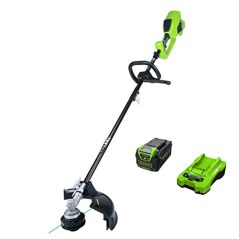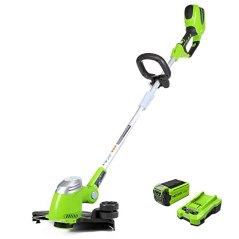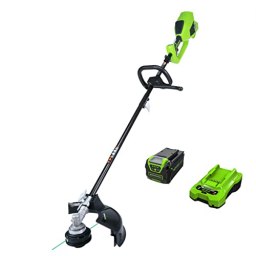Buying guide for Best Greenworks weed eaters
Weeds can grow quickly and pervasively, encroaching on sidewalks, driveways, and gardens while diminishing the beauty of your lawn. A weed eater, also known as a string trimmer because it cuts with a rapidly rotating nylon string, is the tool to employ when you want to keep your outdoor space well manicured, inviting, and healthy.
Founded in 2007, Greenworks has grown to become a trusted name in efficient lawn care devices. Greenworks products are electric, either powered by lithium-ion batteries or corded. They come in various sizes and all are created with efficiency, ease of use, and versatility in mind.
Investing in a Greenworks weed eater requires making a few decisions regarding power, maintenance, and convenience. Our buying guide takes you through how weed eaters work, what tools Greenworks offers, and how to find the right one for your outdoor space. If you already know what you need, check out our recommended products above.
Key considerations
Battery vs. corded
Generally, electric devices like weed eaters don’t offer as much power as their gas counterparts, but for most homeowners, more power isn’t necessary. Electric lawncare items in general and weed eaters in particular are lightweight, easy to store, simple to use, and relatively inexpensive. They are ideal for small to medium lawns and tasks.
Greenworks electric weed eaters either use a lithium-ion battery or connect to an outlet.
Battery: These weed eaters are popular, offering more maneuverability and ease of use than corded models, especially when navigating hard to reach places. They are most cost effective if you have more than one Greenworks tool that uses the same battery.
Depending on the tool and battery, you can work anywhere from 25 to 60 minutes before needing to recharge the battery. Recharging can take a few hours, so it’s a good idea to have a second battery on hand. The battery should last a few years at least, but it requires proper maintenance to keep it functioning as long as possible.
Corded: These weed eaters are cheaper to buy and maintain over time, but the cord limits their range of use. You will probably need to use an extension cord (100 feet, maximum), so make sure you can reach every part of your lawn. You should not connect extension cords together. You will lose power and possibly damage the tool.
Power
Corded options range in power from 4 amps to 10 amps. Battery-powered string trimmers use batteries of 24, 40, 60, or 80 volts. Greenworks helps you make your selection by identifying the size of yard that each tool is best equipped to handle. An 80-volt battery is the most powerful. It’s best reserved for people with large lawns and tough weeds. Most homeowners should find a 40-volt battery sufficient.
Spool feed
There are two types of feeding systems for weed eater spools: auto and bump.
Auto: This system automatically puts out more line when it gets short, allowing you to work continuously. These devices and replacement spools are slightly more expensive and can be difficult to fix if they jam.
Bump: This system requires you to bump the tool on the ground to feed out more line when it gets short. While bump feeds typically use up the line more quickly, they give you more control and freedom to use a longer or shorter line depending on the job.
Cutting width
The cutting path of Greenworks weed eaters typically ranges from 12 to 18 inches. While a larger width will cover more ground at once, it can be more difficult to be precise. You will also likely use up your line more quickly. A narrower cutting path is ideal for smaller spaces but may require more power or work if you’re tackling thick or tough weeds.
Did You Know?
Off-market replacement batteries may be cheaper and offer more power than Greenworks batteries, but they might not fit every tool and may require different maintenance.
Staff
BestReviews
Features
Variable speed
For those moments when you have to deal with particularly tough weeds, you can opt to increase the power and speed for a brief time. While this uses up more battery, the added power is available when you need it most.
Rotating head
Some weed eaters come with a rotating head that can help you get into trickier places. This will also allow you to edge your lawn, provided the soil isn’t too hard.
Attachment capable
Some more expensive models allow you to hook up attachments from other Greenworks devices and even attachments from other manufacturers. With this handy feature, you can turn your weed eater into an edger, pole saw, leaf blower, and potentially more tools provided the attachments are compatible.
Bundles
If the weed eater is your first Greenworks tool, you need to buy a battery and a charger to use the item. Greenworks often bundles these items together in one convenient purchase that is usually cheaper than buying each item separately. What’s more, Greenworks also bundles some tools together, such as a string trimmer and leaf blower, for example.
Extras
Investing in a Greenworks weed eater entails some additional costs for accessories.
Battery: If you opt for battery power, it’s best to have a second battery on hand, especially if you have multiple Greenworks tools. Secondary and replacement batteries cost $100 to $200, depending on voltage. These prices drop significantly if you buy after-market batteries designed to be compatible with Greenworks tools.
Charger: You also need a charger, which costs $25 to $75.
Spool: Extra spools range from $8 to $20.
Weed eaters and other outdoor electric tools come with additional costs like batteries and chargers. Track the potential expenses, both immediate and long term, to see if the investment is right for you.
Staff
BestReviews
Accessories
Greenworks lawn mower: Pro Cordless Lawn Mower
Lawn maintenance starts with keeping the grass cut. We recommend this Greenworks 21-inch, 80-volt cordless mower that’s ideal for small to medium lawns. It can run up to 45 minutes on a charge.
Hedge trimmer: Greenworks Corded Hedge Trimmer
Keep your bushes looking shapely with a hedge trimmer. Greenworks offers an inexpensive 22-inch corded model that comes with a lot of power despite its slim build.
Edger: Greenworks Corded Edger
Weed eaters can do a little bit of edging, but for jobs that require more power and depth, you need a proper edger. Greenworks boasts a 12-amp corded model that gives you both power and precision.
Did You Know?
Greenworks batteries work across dozens of tools. The most common, the 40-volt battery, is compatible with more than 25 other devices in the Greenworks lineup.
Staff
BestReviews
Greenworks weed eater prices
Inexpensive: For under $75, you can find corded electric weed eaters of various sizes with some handy features, including attachment compatibility.
Mid-range: Most Greenworks battery-powered weed eaters cost between $75 and $150. These vary in size and power, and the battery may or may not be included.
Expensive: For over $150, you can buy a powerful weed eater that includes a battery, perhaps a charger, and sports impressive features like attachment capability.
Tips
- Mow your lawn first. Do this before you attempt any trimming, edging, or other yard maintenance. It will make those tasks easier.
- Don’t throw away dead batteries. Take lithium-ion batteries to a certified recycling center. If a battery cracks or breaks, seal it with tape before disposing of it safely.
- Consider the different tools you need. If you’re planning on amassing a collection of outdoor tools, it’s best to go with battery-operated ones from the same company to take advantage of the compatibility of the tools.
- Keep the battery fully charged. Avoid using a battery that doesn’t have a full charge. If the battery runs out in the middle of a task, you might need to wait a few hours or a day before you can finish.
FAQ
Q. How do I maintain my weed eater?
A. Grenworks tools are relatively easy to take care of. After each use, wipe off any trapped soil or grass so it doesn’t harden and make cleaning more complicated. Store your tool in a cool, dry place. Remove the battery and recharge it after each job. For the off-season, fully charge the battery and remove it from the charger. Store the battery, charger, and tool in a dry place that doesn’t experience extremes in temperature.
Q. What safety measures should I take when using a weed eater?
A. Greenworks weed eaters are generally safe, but you’re advised to wear proper gear when using one. Keep your feet, ankles, hands, wrists, and eyes protected from any flying dirt, dust, grass, sticks, and rocks. Be mindful of the heat and sun when working outside, too. Stop using the tool if it starts to overheat. Finally, make sure the device is turned off before attempting to free any weeds from the spool.
Q. How do I take care of the battery?
A. The battery should be fully charged the first time you use it. It might be best to leave it on the charger overnight. Refrain from depleting the battery completely. Once you notice the tool is performing at less than maximum power, stop using it and recharge the battery. The battery won’t be harmed by being left on the charger provided it’s charging at room temperature and not near any moisture, dirt, dust, or heat source.






















